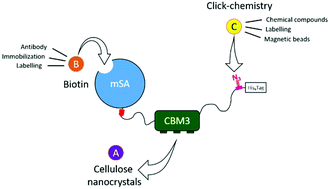A tripartite carbohydrate-binding module to functionalize cellulose nanocrystals†
Abstract
The development of protein and microorganism engineering have led to rising expectations of biotechnology in the design of emerging biomaterials, putatively of high interest to reduce our dependence on fossil carbon resources. In this way, cellulose, a renewable carbon based polysaccharide and derived products, displays unique properties used in many industrial applications. Although the functionalization of cellulose is common, it is however limited in terms of number and type of functions. In this work, a Carbohydrate-Binding Module (CBM) was used as a central core to provide a versatile strategy to bring a large diversity of functions to cellulose surfaces. CBM3a from Clostridium thermocellum, which has a high affinity for crystalline cellulose, was flanked through linkers with a streptavidin domain and an azide group introduced through a non-canonical amino acid. Each of these two extra domains was effectively produced and functionalized with a variety of biological and chemical molecules. Structural properties of the resulting tripartite chimeric protein were investigated using molecular modelling approaches, and its potential for the multi-functionalization of cellulose was confirmed experimentally. As a proof of concept, we show that cellulose can be labelled with a fluorescent version of the tripartite protein grafted to magnetic beads and captured using a magnet.



 Please wait while we load your content...
Please wait while we load your content...